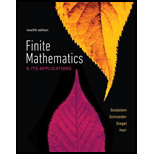
Concept explainers
First Paradox: Under certain circumstances, you have your best chance of winning a tennis
tournament if you play most of your games against the best possible opponent.
Alice and her two sisters, Betty and Carol, are avid tennis players. Betty is the best of the three sisters, and Carol plays at the same level as Alice. Alice defeats Carol 50% of the time but only defeats Betty 40% of the time.
Alice’s mother offers to give her $100 if she can win two consecutive games when playing three alternating games against her two sisters. Since the games will alternate, Alice has two possibilities for the sequence of opponents. One possibility is to play the first game against Betty, followed by a game with Carol, and then another game with Betty. We will refer to this sequence as BCB. The other possible sequence is CBC.
Calculate the probability of Alice getting the $100 reward if she chooses the sequence CBC.
Want to see the full answer?
Check out a sample textbook solution
Chapter 6 Solutions
Finite Mathematics & Its Applications (12th Edition)
- In 2012, the employees of Radcliff Ltd. agreed to purchase 5% of the share capital of 10 million shares of $2 each. There are 20 employees in the plan, and each purchased an equal number of shares. Johnson works at Radcliff Ltd. What would be his ESOP share deduction? $45,000 $25,000 $75,000 $50,000.arrow_forwardInstructions. "I have written solutions in text form, but I need experts to rewrite them in handwriting from A to Z, exactly as I have written, without any changes."arrow_forwardBoth in images okk. Instructions. "I have written solutions in text form, but I need experts to rewrite them in handwriting from A to Z, exactly as I have written, without any changes."arrow_forward
- Question 1: If a barometer were built using oil (p = 0.92 g/cm³) instead of mercury (p = 13.6 g/cm³), would the column of oil be higher than, lower than, or the same as the column of mercury at 1.00 atm? If the level is different, by what factor? Explain. (5 pts) Solution: A barometer works based on the principle that the pressure exerted by the liquid column balances atmospheric pressure. The pressure is given by: P = pgh Since the atmospheric pressure remains constant (P = 1.00 atm), the height of the liquid column is inversely proportional to its density: Step 1: Given Data PHg hol=hgx Poil • Density of mercury: PHg = 13.6 g/cm³ Density of oil: Poil = 0.92 g/cm³ • Standard height of mercury at 1.00 atm: hμg Step 2: Compute Height of Oil = 760 mm = 0.760 m 13.6 hoil = 0.760 x 0.92 hoil = 0.760 × 14.78 hoil = 11.23 m Step 3: Compare Heights Since oil is less dense than mercury, the column of oil must be much taller than that of mercury. The factor by which it is taller is: Final…arrow_forwardQuestion 3: A sealed flask at room temperature contains a mixture of neon (Ne) and nitrogen (N2) gases. Ne has a mass of 3.25 g and exerts a pressure of 48.2 torr. . N2 contributes a pressure of 142 torr. • What is the mass of the N2 in the flask? • Atomic mass of Ne = 20.1797 g/mol • Atomic mass of N = 14.0067 g/mol Solution: We will use the Ideal Gas Law to determine the number of moles of each gas and calculate the mass of N2. PV = nRT where: • P = total pressure • V volume of the flask (same for both gases) n = number of moles of gas • R 0.0821 L atm/mol K • T = Room temperature (assume 298 K) Since both gases are in the same flask, their partial pressures correspond to their mole fractions. Step 1: Convert Pressures to Atmospheres 48.2 PNe = 0.0634 atm 760 142 PN2 = = 0.1868 atm 760 Step 2: Determine Moles of Ne nNe = mass molar mass 3.25 nNe 20.1797 nne 0.1611 mol Step 3: Use Partial Pressure Ratio to Find narrow_forward"I have written solutions in text form, but I need experts to rewrite them in handwriting from A to Z, exactly as I have written, without any changes."arrow_forward
- No chatgpt pls will upvote Already got wrong chatgpt answerarrow_forwardConstruct a table of values for all the nonprincipal Dirichlet characters mod 16.arrow_forwardMI P X /courses/segura10706/products/171960/pages/611?locale=&platformId=1030&lms=Y ☆ Finish Part I: Mathematics for Elementary and Middle School Teachers Continue in the app JJ 576 Chapter 12. Area of Shapes 9. Determine the area of the shaded shapes in Figure 12.48. Explain your reasoning. 1 unit S Figure 12.48 1 unit unit and the yarn for thearrow_forward
- Suppose p > 3 is a prime. Show that (p − 3)!= − P+1 (mod p). Hint: Use Wilson's theorem.arrow_forwardWhich graph represents f(x) = √x-2+3?arrow_forwardSuppose a = p²¹...p be the canonical factorization. Then the sum of all the factors of a, denoted by σ(a) is given by o(a) = II + k₂+1 P -1 Pi - 1 (you don't need to prove this). (a) Let a = 2³ × 7². Find σ(a), which the sum of all the factors a.arrow_forward
 Big Ideas Math A Bridge To Success Algebra 1: Stu...AlgebraISBN:9781680331141Author:HOUGHTON MIFFLIN HARCOURTPublisher:Houghton Mifflin Harcourt
Big Ideas Math A Bridge To Success Algebra 1: Stu...AlgebraISBN:9781680331141Author:HOUGHTON MIFFLIN HARCOURTPublisher:Houghton Mifflin Harcourt
